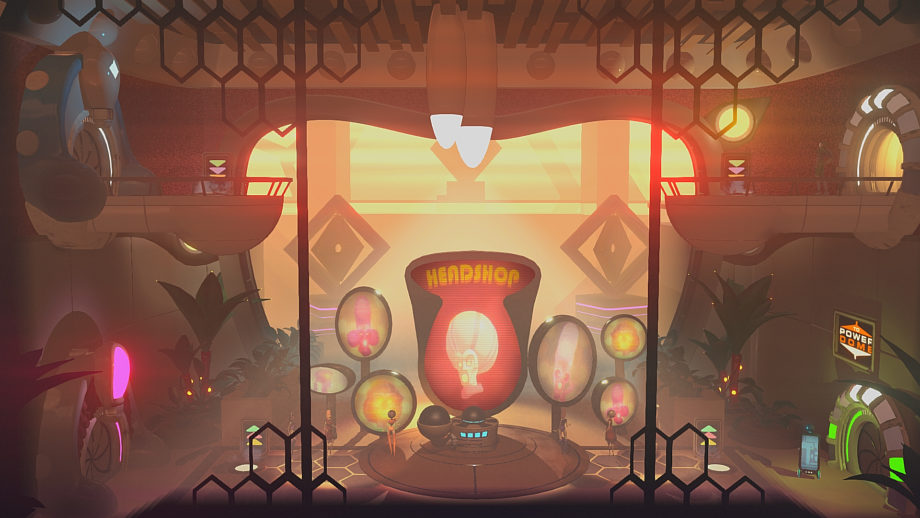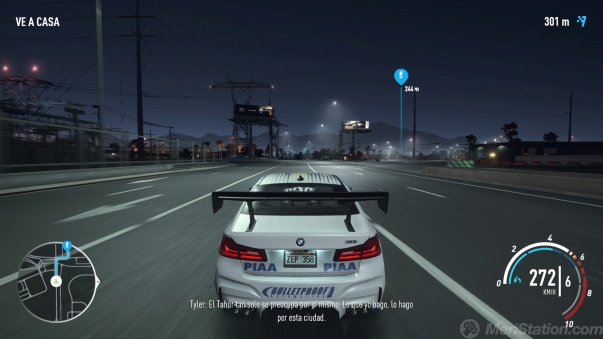A space metroidvania whose trailer already made references to the fantastic and horror movies of the 70s where jokes and absurd situations are plentiful, in which we control a head with the objective of helping a robotic rebellion in a universe of alienated mechanical workers. It sounds good, right?
Headlander is the new work of Double Fine, the independent studio founded by Tim Schafer (The Secret of Monkey Island, Grim Fandango), orchestrated by Lee Petty, who already
dealt with Stacking and Autonomous. It is not surprising that from such minds, without any fear of experimentation, with their baggage in playful humor and constant headlong go a game that deals precisely with this.
Our protagonist (whose head we can choose at the start of the game) wakes up without remembering who he is or where he comes from, with the surprise that, well, it seems that we do not have legs, arms or any other limb. We are just a head that can fly thanks to its
scuba, propel itself and tie itself to other bodies that it can control. Throughout our adventure we are accompanied by a robotic presence that will help us understand the mechanics of the game at the beginning of it, as well as the history and the universe in which we are.
It is a world of science fiction, of space stations where humans have lost their real bodies to transfer their minds to eighties aesthetic robots.
In those tin suits the “life” takes place in a way that refers, on the one hand, to the hippie era, with robots that get into psychedelic experiences, take “downloads” and dance in the disco with their afro hairstyles; On the other hand, Headlander introduces us to a critique of the typical capitalist production model in science fiction narratives.
The citizens of this world have a stone implanted to prevent them from thinking too much. They work for long journeys, sometimes in jobs that can be automated just to keep them busy in exhausting tasks for the leader’s rejoicing and the architect of this dystopia:
Methuselah, an evil entity that controls the world that it has created. However, we will meet some rebels who have survived after getting rid of the stone that stuns their minds and that are also helped by that voice-over that guides us and gives us orders throughout the 7 or 8 hours of adventure.
The objective of the rebellion? Bring back their cabales to the “human” society, recover the bodies, the carnal life that has been lost thanks to progress.
To do this the game proposes a metroidvania mechanics, combining platforms, puzzles and confrontations, some of which work as puzzles in themselves. You can expect elevators, doors that only react to a laser of a certain color, secret paths that we can not open until we acquire a certain power and teleporters that will take us from one part of the map to another.
The combats and the majority of puzzles have their particularity because they are based on the fact that the lasers we shoot bounce around the scenes;
holding down the right mouse button we see the trajectory that will follow the projectiles that will fill the screen with color, allowing us to calculate the best shot against the head of an enemy robot or the trajectory to reach an enemy that is on us in vertical scenarios .
But all this is complemented by the pillar of the game: the possibility of taking off our heads at any time, which we directly handle, and being able to tear off the heads of the robots to move on to handle their bodies, or sneak through nooks and crannies, dodging the
lasers that will fill the screen and ambush the enemies. In addition, little by little we are improving our flying head allowing it to make attacks or that,
coupled in a body, we can headbut another robot to put our gray matter on their shoulders, among many other skills. Thus, we can exchange our body for a robot of a higher level color to get open the doors for which previously we had no authorization, or get other types of robots and bodies needed for additional missions


